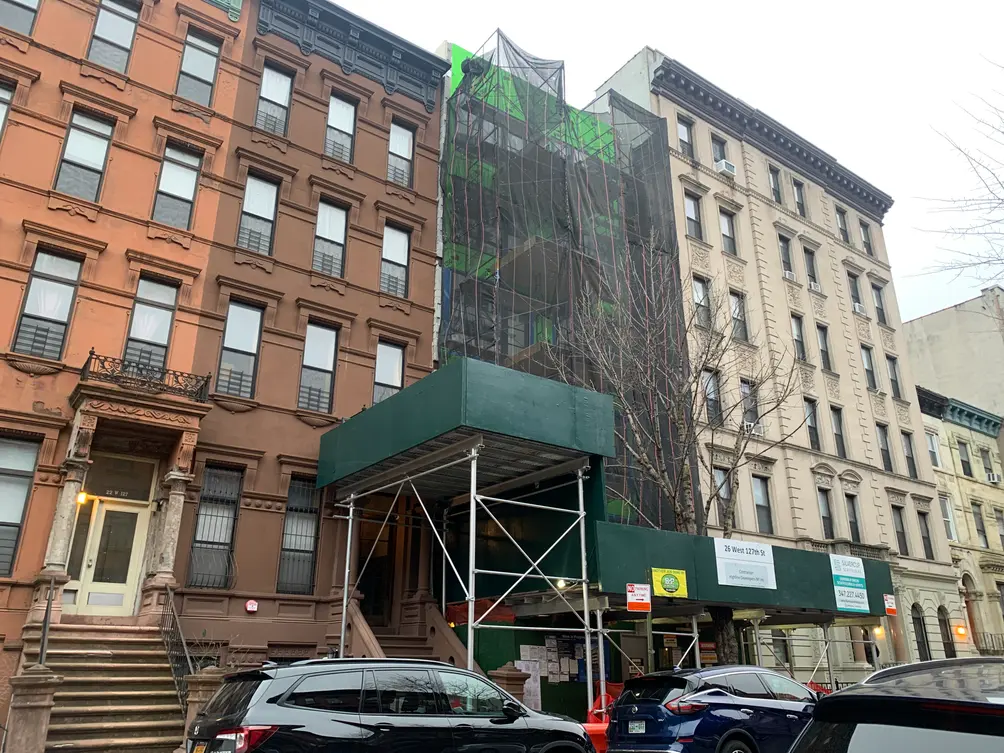For the most part, Central Harlem's side-streets have retained their historic cohesiveness despite suffering from a healthy dose of rather callous post-war development. While the great majority of the uptown neighborhood remains unprotected by city landmark designation, restrictive zoning largely ensures new infill projects reflect the scale of the surrounding area (though not the style).
Harlem's historic blocks are dominated by stately three- and four-story brownstone rows largely built in the late 1800s in Queen Anne, Romanesque, and Neo-Grec styles. Following the dramatic downturn of the neighborhood following the Great Depression, decades of disinvestment and neglect resulted in a once seamless streetscape eroded by vacant lots and abandoned properties. Throughout the mid-20th century, as the city grew further impoverished and as architectural tastes changed, countless pre-war Harlem buildings underwent insensitive alterations to host new uses and spaces for the residents and businesses determined to stay.
Harlem's historic blocks are dominated by stately three- and four-story brownstone rows largely built in the late 1800s in Queen Anne, Romanesque, and Neo-Grec styles. Following the dramatic downturn of the neighborhood following the Great Depression, decades of disinvestment and neglect resulted in a once seamless streetscape eroded by vacant lots and abandoned properties. Throughout the mid-20th century, as the city grew further impoverished and as architectural tastes changed, countless pre-war Harlem buildings underwent insensitive alterations to host new uses and spaces for the residents and businesses determined to stay.
In this article:
One such example lies at 26 West 127th Street where a three-story wood-framed house, seemingly dating from the early beginnings of the neighborhood, was converted into a mixed-use structure with a house of worship (most recently Mount Zion Baptist Church) and apartments above. In 2017, Jonathan Rosenberg under 26 WEST 127 OWNER LLC purchased the property from the congregation for $1 million and then after filed permits to build a six-floor, 12-unit apartment building. The growing-in-popularity J Frankl Associates is responsible for the design, which a rendering posted on-site shows will be an inoffensive red-brick building with glass balconies a bit too egregious. While there will be no gracious stoop and ornate railing leading to the entrance, a simple blue-toned cornice-line, matching the color of mullions throughout, will top the structure.
 Construction progress at 26 West 127th Street as of March 2020
Construction progress at 26 West 127th Street as of March 2020
A recent visit to the site shows we'll have to wait a bit longer to see if the reality lives up to the rendering. The 60-foot structure is topped out and mostly enclosed but has yet to apply its final brick facade. If the pandemic allows work (and the real estate market) to fully resume in weeks rather than months, the project could be complete by year's end.
At 12 apartments with two units per floor, it appears the project will likely be a rental building. Currently, there are 253 apartments for rent in Central Harlem where one-bedrooms come in at a median of $2,275/month and two-bedrooms at $2,695/month.
At 12 apartments with two units per floor, it appears the project will likely be a rental building. Currently, there are 253 apartments for rent in Central Harlem where one-bedrooms come in at a median of $2,275/month and two-bedrooms at $2,695/month.
Would you like to tour any of these properties?


 6sqft delivers the latest on real estate, architecture, and design, straight from New York City.
6sqft delivers the latest on real estate, architecture, and design, straight from New York City.
